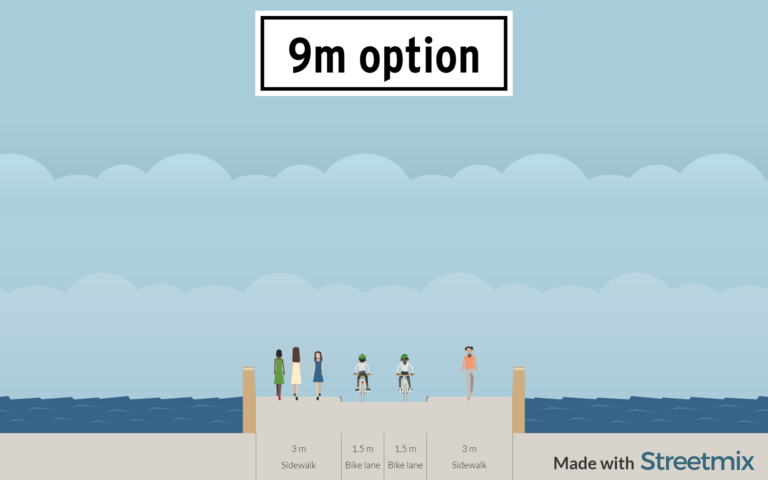You may have seen recent coverage of the proposed new bridge linking Wynyard Quarter to the Viaduct, replacing the existing bridge, which was put in place in 2009 as a 2011 Rugby World Cup ‘legacy project’.
As Greater Auckland notes, the timeline for the new bridge is tight: delivery is ideally tied to the Americas’ Cup in 2021, and planning and design is already well under way.
As the voice for people on bikes in Auckland, we recently sought an opportunity to give expert feedback on this vital link before the details are set in stone. Read on for our thoughts; we’re eager to hear yours, too.
The context
The current ‘temporary’ bridge has, in its short lifespan, become a vital link for people walking, biking, and scooting along the waterfront. And there are more of them every day.
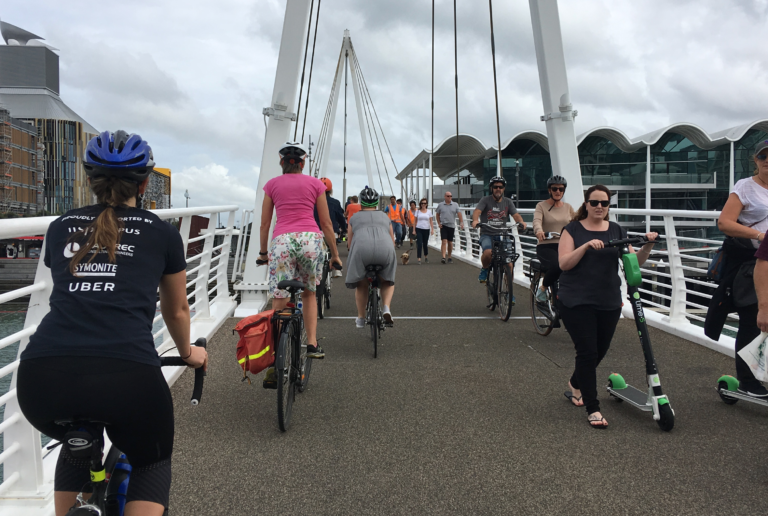
That’s because a lot can happen in a decade, including:
- The former industrial area is now booming with offices, housing, and restaurants; the central city population is growing; and the waterfront has become ever more people-friendly.
- Transport-wise, Wynyard Quarter’s district management plan requires single-occupant car use to fall to 30% by 2030, meaning even more people getting around on foot and two wheels.
- Share-bikes and e-scooters are creating new grab-and-go opportunities for locals and visitors alike.
Even before the flood of bike traffic that opening up the Harbour Bridge for walking and biking will inevitably bring, the upward growth is clear. Notice, too, how the dominant mode has shifted from weekend leisure to workday trips within the last year.
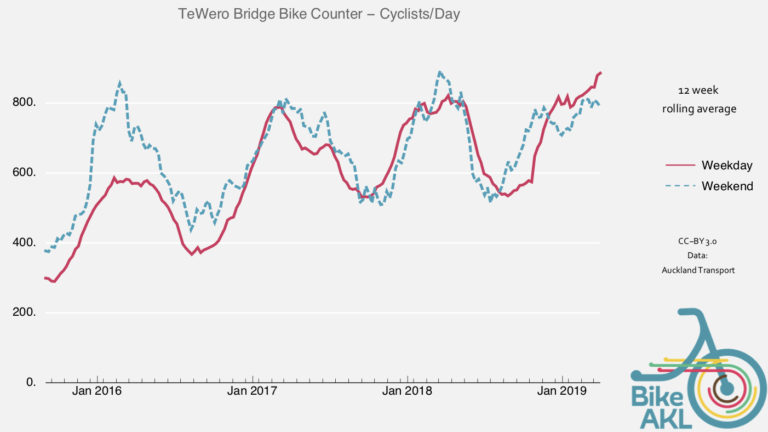
What’s proposed
The new bridge is an eye-catching ‘double leaf’ bascule bridge, with origami-esque styling to evoke yacht masts and seabirds. As seen in this video, it features a clever incy-wincy spider opening movement to let boats through. The 6m wide deck surface, i.e. the usable part for most of us, would be wider than the current 4.4m, but not by much.
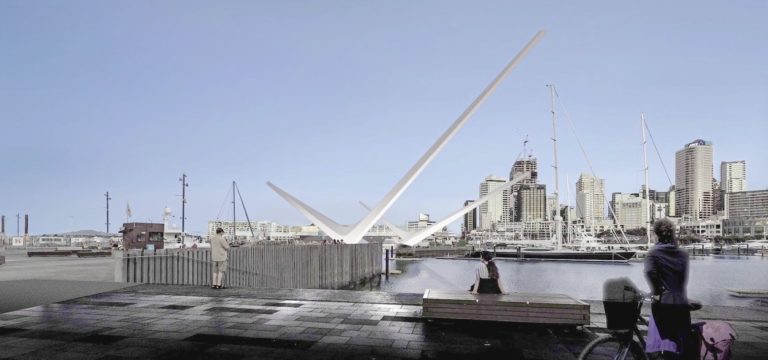
What’s the problem?
We consider that the proposed design would be a very striking replacement, and we do like these aspects of the design:
- it removes the existing central pillars which currently constrain the movement path
- it provides a more level crossing
- it’s wider than the existing bridge
- in particular, we appreciate the team’s work on shortening the length of the narrowest section.
Our key concern is that this is being planned as a shared path. Bearing in mind this bridge is intended to serve for 50-100 years, neither the width nor the layout are future-proofed – or indeed present-proofed! – to allow for separate travel space for bikes and scooters, and that’s a problem.
Shared spaces have their place. But they also have their limits, especially wherever there are large numbers of both pedestrians and cyclists / scooters penned together in a ‘one size fits all’ fashion that compromises everyone.
On this subject, we share common cause with groups such as the City Centre Resident’s Group, Walk Auckland / Living Streets, and disability advocacy groups, who’ve expressed regular concern at the continued use of shared spaces and paths in areas where these are not appropriate.
Some spaces in the area – such as the sea-side of North Wharf and its restaurants – are and will remain suitable as permanent shared spaces. But the link between Wynyard Quarter and the city centre waterfront forms a very significant transport route for people walking, on bikes and on scooters, and should be designed for these multiple uses.
And while the areas west and east of the proposed bridge are currently shared spaces, we expect that will change, thanks to the massive growth in bikes, scooters and other faster-than-walking active mobility. Indeed it should change – soon, and certainly within the proposed 50-100 year life of this bridge.
Just as shared spaces are viable with a maximum limit of motor vehicle trips, so too should they have a maximum limit of bike/scooter trips before they need redesigning. With well over a thousand bike trips recorded on the busiest days (including a January ‘high score’ of 1684) we say the proposed bridge design must reflect reality.
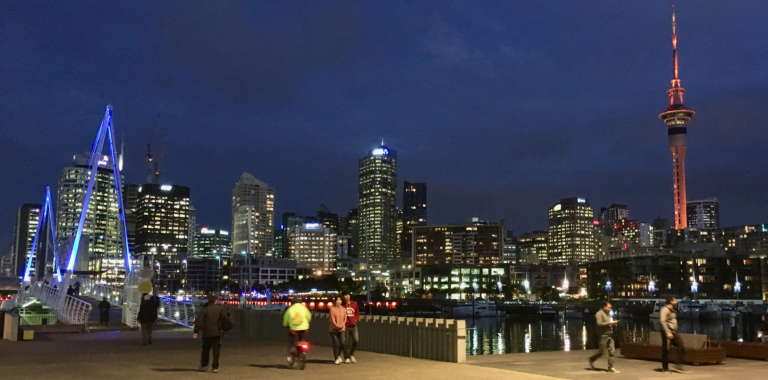
Our solution(s)
To allow the bridge to work efficiently, comfortably, and safely for all, we ask for it to be widened to 9m, with 3m footpaths each side of a 3m central cycling / scooting lane. The arrangement of kerbed footpaths plus a central travel lane is well understood by people using it. In our view, until bikeways are provided leading up to the bridge, you wouldn’t need any specific markings on the bridge itself. We’d lean towards gentle (but physical!) reminders to ‘share with care’, with slower travelers on the outside, and faster users in the centre.
If widening to 9m is not seen as feasible, we instead suggest an arrangement with softer separation: two 2m footpaths each side, edges by 0.3m chamfered kerbs (as specified by Auckland Transport for future cycleways) with a 2.5m bike / scooter lane in the centre. This would be narrower, but still provide visual and physical separation. The gently ramped kerb ensures that the narrower width works well for crowded periods when pedestrians might occupy the whole space.
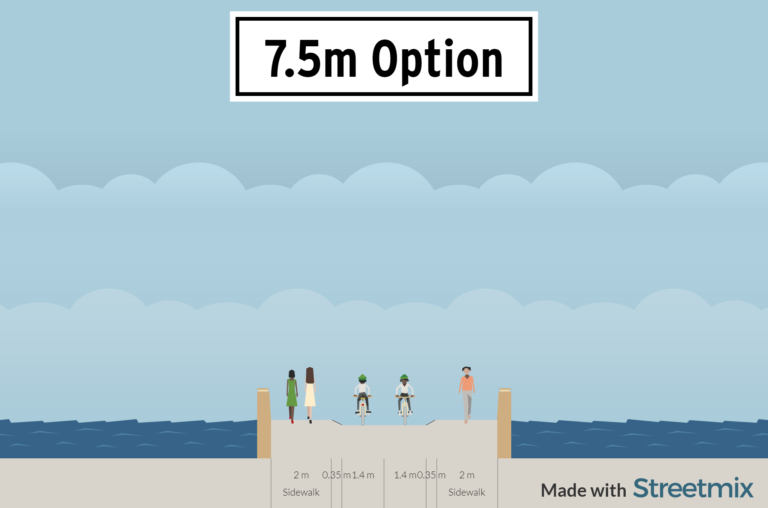
We’ve also asked the team to review the following issues:
- People will want to stop on the bridge itself to take photos, with knock-on effects on through-travel. To clear the path for those moving through, consider adding slightly elevated viewing platforms at the widened abutment areas.
- The proposed design has a diagonal central joint where the two bridge parts connect. Please ensure the ‘seam’ is robustly designed not to catch the wheels of bikes, scooters, wheelchairs, etc (including skinny road-bike tires).
- For the gate-systems at each end, please don’t reintroduce central pillars! These are a significant collision hazard, especially bollard-width or narrower. In a crowd, a thin bollard can easily be missed, leading even slow riders to crash.
- Please ensure bike access during construction, i.e. not detouring bikes around the basin while pedestrians (and scooters? and wheelchair users?) continue to have direct access. Depending on the conditions, we acknowledge that dismounting while crossing may be necessary for safety.
We’re also glad to confirm that the future bridge won’t require riders to dismount, but rather to slow down as appropriate and behave in a safe and polite fashion. We nevertheless reiterate the request for separated bike/ scooter space.
That’s our feedback in a nutshell – our thanks to Panuku and the design team for the opportunity to provide comment. Now, over to you. What are your thoughts and questions?


